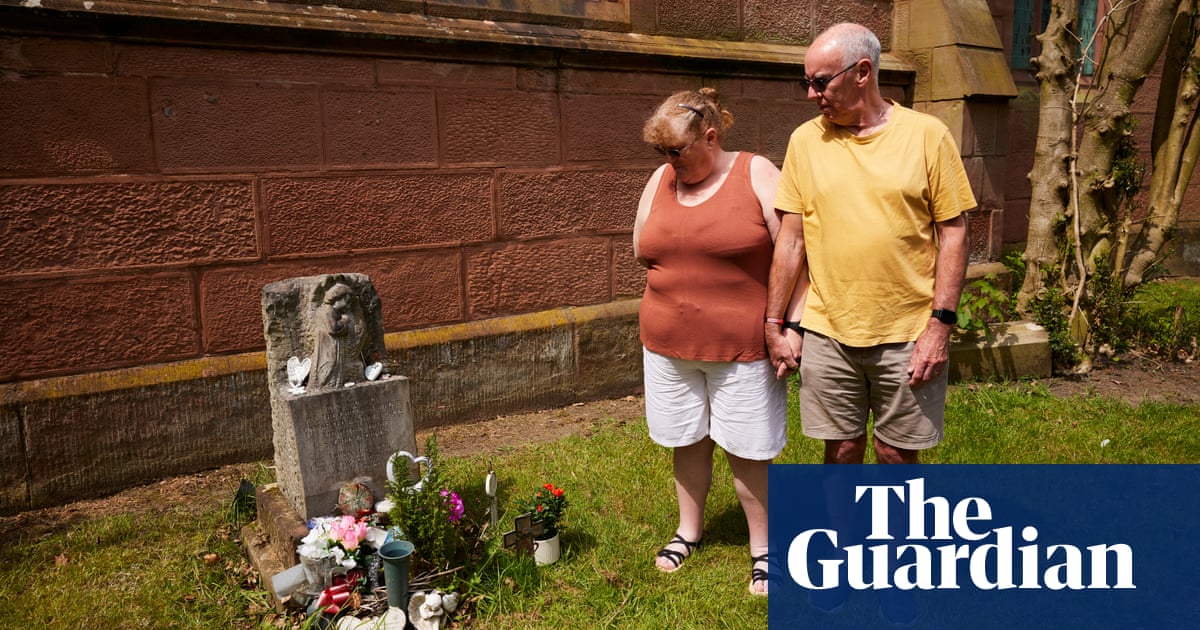
As late as the 1990s, healthcare professionals assumed that if a parent saw their stillborn baby or established any kind of connection with them this would only deepen their grief.
As a result, thousands of babies were abruptly taken from their parents, denying them the chance to say goodbye. Many were buried in mass graves across the country – but parents were often told different or conflicting stories. Most did not know where their children were laid to rest.
Charities such as Brief Lives Remembered, run by Paula Jackson, help bereaved parents find the graves of their stillborn children. Here are some of those parents who were reunited with their lost ones.
Michelle and Richard Jones
Michelle Jones, 62, delivered a stillborn son, Christopher, in February 1981. She had visited the GP shortly before concerned she could no longer feel him kicking. The GP at the time reassured her that he could detect a heartbeat.
Later, after experiencing significant pains while out shopping and being violently sick, she went to hospital and was taken to a ward. She was told by medical staff that a heartbeat could not be found and the baby had died.
“When I gave birth to Christopher, they whisked him away,” Michelle recalls. “When I asked the team later in the day, they said no. I couldn’t see him because he was already on his way to be buried.”
Michelle and her husband, Richard, 67, were told the baby would be buried with another person – a common explanation given at the time – that later turned out to be untrue.
The couple tried to find out where he was buried up until the mid-90s but were never successful. After seeing a television report two years ago, they were ultimately put in touch with Paula Jackson at Brief Lives Remembered.
“Paula phoned me back within a couple of days,” Richard says. “She says: ‘I think I’ve found him.’” A couple of days later Jackson confirmed she had – Christopher was buried at St Ann’s church in Rainhill, Merseyside. The Joneses now live in Wigan but have frequently passed the churchyard on the way to visit their daughter.
“The number of times we drove past this church. It’s just sickening,” Richard says.
Explaining why it was important for them to find Christopher, Michelle says: “You weren’t given truth. Now you can spend time with your baby, you get photos taken, footprints, handprints. Back in those days there was just nothing.”
“The attitude was you were pregnant, you lost that child, it meant nothing,” Richard adds. “But it does.”
Margaret Thomas
Margaret Thomas, 70, had a stillborn son in 1976 in Liverpool. She had a difficult delivery and her son suffered a brain haemorrhage.
“The nurse said he was a beautiful baby,” she recalls. “He was a nine-and-a-half-pound (4.3kg) baby boy and … all I saw was the top of his head when he got whisked out.”
“It’s heartbreaking, you never get to see them, they’re just taken away from you.”
The hospital paid for the burial – but Margaret and her husband, Wyn, 73, had no idea which cemetery he was in.
Last year Margaret’s hairdresser told her about Paula Jackson. She decided to get in touch. “I told her everything and then within three days she found them,” Margaret says. “I was just amazed. I expected it to go on for weeks and weeks.”
Margaret’s baby, whom she would name Marc Wyn, was found in Toxteth cemetery. “It was just a grass patch,” she says. “I wanted to mark it. I put a wooden plaque in the place.”
The trauma haunted her husband too. “He used to say: ‘I’m having dreams about the baby’, the baby was saying: ‘You’d forgotten about me.’”
Margaret, who has three other children, does not think that “it was just the time” is a satisfactory explanation or excuse. “Even for the time, I think you should have been able to at least have seen them,” she says.
Ruth Kent
Ruth Kent, now 86, had a stillborn daughter in March 1964. She was living in Woodley, just outside Reading, and was due to go to a nursing home to have the baby. But three weeks overdue, she was induced and, when the baby appeared to be in distress, was transferred to Battle hospital in Reading.
“They got me to sign papers to say I was willing to have a caesarean,” she recalls. “They left me, left me and left me. The next thing I knew I had lost the baby. When I came to, it was my late husband who told me the baby had died. They took me back into a ward with all the mothers, at feeding time. The nurse said: ‘Put some makeup on, your husband will be here soon.’”
After the birth, she was not permitted to see the baby despite “pleading” with them: “‘Oh you’ll forget about this,’ I was told.”
Ruth could not bear to stay in her Reading home and moved away to Ruislip. “I couldn’t cope with the nursery that was all done up, people didn’t want to talk to me.”
She went on to have children and is now a grandmother, but she says she always wondered what happened to her stillborn daughter. She contacted Paula Jackson after seeing her on television and her baby was found at a cemetery in Reading.
“You don’t forget as a mother,” she says.
Joy and Phil Hancock
Joy Hancock had a stillborn baby, later named Guy, in 1965. She gave birth in a private hospital in Wimbledon and after five hours of labour the child died due to a prolapsed cord. It was the first baby for Joy and her husband, Phil.
“They must have told me he was dead, the baby,” Joy, now 82, recalls. “Then they gave me an injection, the next thing I remember was waking up.”
After the labour, nothing was really explained. “We never saw the baby, the baby was taken away … I didn’t ask what had happened to the baby. A couple weeks after I got home, I said: ‘What happened? Did you just throw the baby away?’ The grief came then.”
Joy says it was “hardly ever discussed”, which she describes as “extraordinary now”. The baby was taken away, cremated, and put into a mass grave. “Years went by, I never felt like I could mention the baby by name,” she says.
She and Phil, now 84, had another baby the following year and ultimately had three children. Years passed, they lived in the USA, France.
She discovered Brief Lives Remembered and Paula Jackson helped her find Guy.
“It was extraordinary. She is just so lovely and helpful. She said it might take months. We had no idea where he was buried. The hospital had since been closed so there were no records. I asked for his death certificate. We did get that. Buried in the borough of Merton. She went on with the investigation, then I had this amazing phone call.”
Guy had been buried at a cemetery in Streatham, south London. The cemetery was being renovated and the area where Guy had been buried was covered in dead trees, mud. A caretaker helped them pace out the area so they could identify where Guy was buried. A friend accompanied them and performed a burial service.
They have since ordered a bench to be placed in the grounds of Worcester Cathedral, in the city where they now live. “It will be somewhere to sit and think about what might have been,” she says. “Our lives would have been totally different. These things happen in a split second. Guy would have been 60 next year, and I can still remember that day vividly.”












